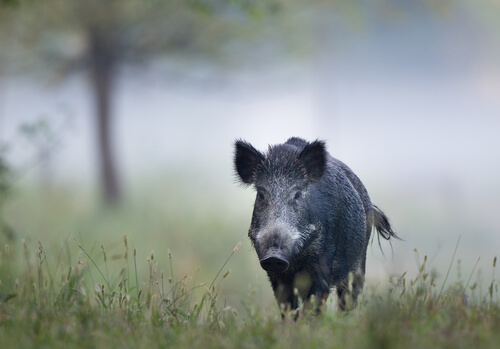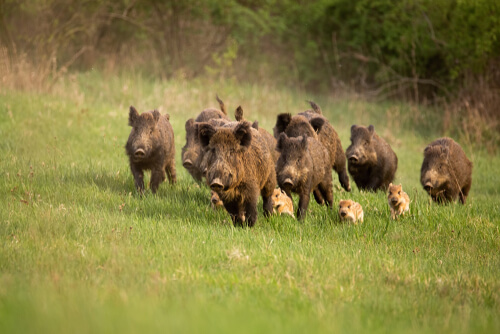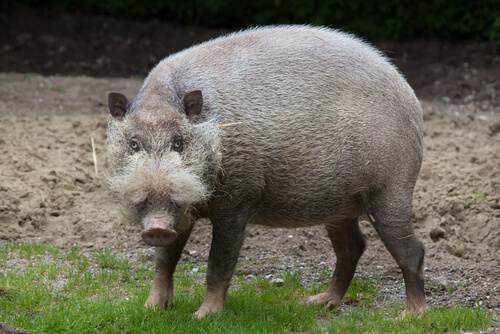
| Kingdom | Animalia |
| Phylum | Chordata |
| Class | Mammalia |
| Order | Artiodactyla |
| Family | Suidae |
| Genus | Sus |
| Species | Sus scrofa, Sus scrofa domesticus |
| Niche | Disruptive omnivores |
| Length | 35-78 inches (90-200 cm) |
| Height | 21-47 inches (55-120 cm) |
| Weight | 130-220 lbs (60-100 kg) |
| Lifespan | 4-5 years in the wild, up to 20 years domesticated |
| Social Structure | Matriarchal female groups (sounders), solitary males |
| Conservation Status | Least concern |
| Preferred Habitat | Grassy savannas, wooded forests, shrublands, marshlands |
| Average Litter Size | 4-6 |
| Main Food Items and Prey | Roots, nuts, fruits, small rodents, insects, eggs |
| Predators | Grey wolf, Tiger, Komodo dragon, humans |
The Basics
Boar refers to members of the genus Sus, including the Wild boar (Sus scrofa) and the domestic pig (Sus scrofa domesticus), a subspecies. Wild boars are native to Eurasia and North Africa but have been introduced to the Americas and Oceania (Australia, Melanesia, Micronesia, Polynesia). This makes them one of the widest-ranging mammals on the planet. Thus, wild boars listed as “Least Concern” by the IUCN.
As they are the ancestors of domestic pigs, their appearance is familiar to most. They have a long snout with a blunt end with small eyes and large ears. They have a coat of thick, short hair. Some wild subspecies have a mane-like feature on their necks and back whereas domestic pigs have less hair than their wild ancestors. They are usually brown or even near black and have tusks emerging from the sides of their mouths, larger in males than females. They weigh up to 220 lbs (100 kg) and grow up to 78 inches (200 cm) long excluding their tail. At the shoulders, male adults stand up to 47 inches (120 cm) tall at their shoulders.
Social Structure, Mating, and Reproduction
Wild boars are largely nocturnal, spending most of their day resting in nests made of leaves and other debris. Males are generally solitary, socializing only during breeding season when they will court females and compete with other males for the ability to mate with the females within their territory. Females, known as sows, tend to form groups of breeding females and their offspring. These groups are called “sounders” and vary in size from anywhere between 5 to 30 individuals.
Following a 4-months long pregnancy, a sow will usually give birth to 4-6 piglets in her nest. About 2 months later, the piglets are developed enough to make their first forays from their nest to feed. They are independent after about 7 months of nursing and protection from the sow. Boars are sexually mature after about 2 years while sows reach reproductive age at 1 year.

Diet
Boars will eat almost anything. In the wild, boars will rummage through their habitat in search of fruits, nuts, and more. They also eat the roots of plants and small trees, dislodging them from the soil in the process. As omnivores, they also eat other animals as well. They will invade the nests of birds and reptiles to eat their eggs, or even hunt or inadvertently consume small mammals and insects while browsing. Wild boar will occasionally even hunt the young of larger mammal such as those of livestock like calves or lambs. Domestic boars generally subsist on feed produced specifically for this purpose. Typically, it is a mix of various grains such as rice, maize, soya beans, and cassava as well as vegetables and distiller’s waste.
Domestication
Genetic studies have indicated that wild boar originated from islands in Southeast Asia before spreading to Eurasia and North Africa. The earliest fossils of teeth and tusk date back to the Early Pleistocene, some 2 million years ago. Archaeological evidence suggests that the domestication of boar began at least 15,000 years ago in the Tigris Basin of the Near East. In addition, there is evidence of domestication in Cyprus about 13,000 years ago and again independently in China some 8,000 years ago.
Domestic boars are considered a subspecies of their wild Eurasian ancestors. Besides domestic pigs in Timor and Papua New Guinea, the wild boar is the ancestor of virtually all pig breeds. Domestic boars tend to have much more weight distributed on their hindquarters, whereas wild boar still have much of their muscle mass concentrated around the head and shoulders. Domestic boars don’t have large tusks as their wild ancestors do.
Fun Facts about Boar!
After hunting boar for centuries, humans eventually domesticated them many millennia ago. This long-standing and close association with humankind has resulted in boar and pigs becoming one of the most well-recognized species on the planet.
Invasive Species
Although boar’s adaptability and introduction worldwide has led to their relative success, it has also become a problem for ecosystems to which they were introduced. Boars are notoriously harsh on ecosystems and spend much of their time uprooting trees and plants looking for roots or insects to eat. In effect, they ruin habitat in areas that aren’t adapted to such disruption. In Hawaii, for instance, they have become a serious pest, threatening unique and endemic island ecosystems and species. Because of this, they are hunted freely in many places.

Threatened Elsewhere
Despite being a pest in many regions where they have been introduced, some wild boar populations are actually threatened in their native habitat. In some areas, habitat destruction is a threat whereas in others they have been over-hunted. Infectious diseases are also a threat to some populations, which can increase in likelihood as a result of their interaction with human settlements and livestock, for example.
Wild vs. Feral Boar
Many people might hear the words “Wild” and “Feral” and take them to mean largely the same thing. Although they are similar, there is an important distinction to be made. Wild animals are simply naturalized animals that have not been domesticated by humans in any way. Feral animals, however, are actually domestic animals that have escaped or been released. Some may potentially even build feral populations of animals born in nature but from a domesticated bloodline.
In the case of boars, this is complicated even further by the fact that in recent decades, Wild boars, the ancestors of domestic boars or pigs, have often re-hybridized with feral pigs. These hybrids have become serious pests in many parts of the Americas and Australia. In the US, ‘feral swine’ refers to wild boar, domestic pigs living wild, and hybrids of the two. The closest living wild relative of boar is the Bornean bearded pig (Sus barbatus).

Farmers
Besides being farmed for consumption, some farmers actually use pigs as farm tools as well. Indeed, some Permaculture farmers and homesteaders use pigs in an enclosed, movable pen as ‘pig tractors‘. The pigs then get to work on the land, clearing it of vegetation or turning up hard-packed or clay earth in search of food. This effectively prepares the land for agriculture without the use of human labor or expensive machinery while also feeding the pigs for potential slaughter in an efficient and economical way.
